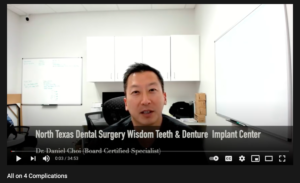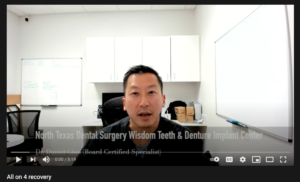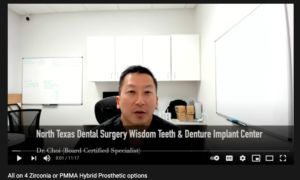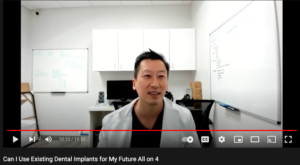How many dental implants do you need when doing an All on 4?
Question is, why are we discussing this? Why should we care? Well, this affects how many teeth we can place in your mouth, which affects your chewing, and how many teeth we see when you smile. If we don’t take these factors into account and place teeth where we shouldn’t, we will cause your implants and therefore your teeth to fail in the future.
To start, you basically need to have at least 4 implants. That’s why they call it All on 4. The general rule of thumb is your upper jaw bone consists of way softer bone. Your lower jaw bone is denser. Just think of the consistency of drywall versus a stud. That’s what your upper jaw bone is like compared to your lower jaw bone.
Imagine you’re trying to hang up a multimillion-dollar painting. If you want to make sure that painting doesn’t fall, make sure you drill into the studs. Imagine you didn’t have studs, make sure you place as many screws up there to help distribute the load. So if you’re placing implants in softer bone, you may need more implants than the typical 4, maybe going to 6 to 8. In the denser lower jaw, you typically need only 4.
Basic principles for traditional implants
- Implants fuse to bone through a process called osseointegration. It takes 3 months for the lower jaw and 4 months for the upper jaw to fully fuse to the bone. It creates such a strong bond that it literally feels like the implant is cemented to the bone.
- We would typically place implants for each individual tooth. Sometimes you can use 2 implants to replace 3 or 4 teeth with a dental implant bridge.
Why All on 4 works despite having fewer implants
All on 4 was a radical concept replacing 12-14 teeth with just 4 implants. It was radical because before this we were typically only placing the implants and then waiting 3-4 months before we proceeded to “load” the teeth onto the implants. Loading refers to bearing the weight of the abutments and the crowns onto the implants and putting them in “function”, meaning chewing, and therefore having forces placed on the implants. Simple analogy, you want to wait for the foundation of your home to set before you start building on it and using it.
The reason the all on 4 concept works is because the implants are long and wide enough when placed into the jaw. The long and wider implants can provide enough support for multiple teeth. This is why we don’t have to place single implants for every tooth or every other tooth.
So can we just place the 4 implants wherever we want? Not at all. We want to make sure we have enough A-P spread, anterior-posterior spread.
Why do my teeth not go back all the way?
There are some anatomical structures we obviously try to avoid when placing dental implants… In the maxilla, the upper jaw, the sinus, and the nasal cavity we want to be aware of. There’s no problem technically drilling into these structures but you’re not getting any support when implants are hanging in an air cavity. Imagine if you drilled into drywall. If you could drill into something soft like drywall, you want to drill into as thick of a wall as you can. If you could drill only into an inch of drywall and the rest of the screw is hanging out in the air, then you’re not going to get as much support. In the mandible, the lower jaw, the inferior alveolar nerve is the main structure we want to be aware of. Drilling into this nerve could lead to paresthesia of the nerve. This nerve isn’t present in the anterior jaw but is present towards the middle and back of the jaw. This is why we angle the back implants to stay away from the nerve. Because of all these factors, we do not want to place implants all the way back to the second molars if there are certain anatomical factors that preclude us from doing this.
Why we spread out your dental implants in an All on 4
Be aware that we’re not just focusing on trying to place only at least 4 implants for an All on 4. If you place them wherever you want without the proper anterior-posterior spread (A-P spread), then what are you accomplishing? You need to have the pillars of supports where they’re needed, hopefully as equidistant as possible. Placing them all at the front, or all at the back, or all too far away from each other will result in the prosthesis or implants failing. If too much force is placed on an implant, this is what’s called overloading an implant. Unfortunately, overloading an implant can result in the implant losing bone and then eventually failing.
A specific example of overloading is seen when there are excessive distal cantilevers that occur. That means that you try to hook on too many teeth on the backside of your last implant.
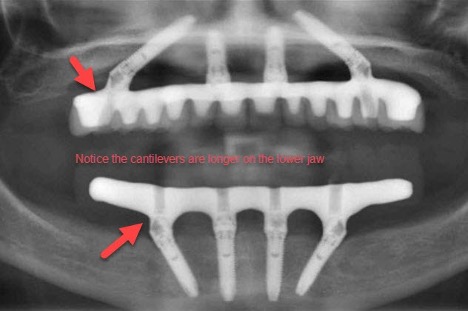
Take a look at this photo. Notice in the upper jaw there isn’t as many teeth hooked on as in the lower jaw. The lower jaw has more of an extension off the back of the last implant than the upper jaw. The reason is that the upper jaw has softer bone and therefore doesn’t like to have excessive pressure placed on those back teeth. The lower jaw has more dense bone and can handle more distal cantilever pressure. There’s an equation that helps to figure out how far you can hang a distal cantilever off the back. For the lower jaw, you can add 1.5x the length of your most anterior implant to the posterior implant. For the upper jaw, you can typically only add another 8mm, which is basically another tooth. So if you want to add a second molar, it’s best to get an implant in the first molar space. Most people get up to the first molar. In that case, it’s best to get an implant placed in the second premolar space.

